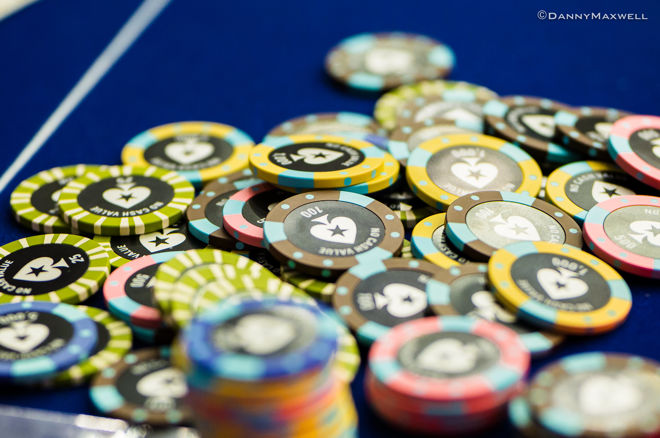Let’s talk a little about bankroll management and tournaments, an area that sometimes trips up even experienced poker players who aren’t as mindful as they should be of how the variance of MTTs should affect what buy-in levels they choose.
MTT bankroll management: Why have a bankroll?
It goes without saying — a “poker bankroll” refers to money set aside for poker only, and should not overlap with living expenses or other funds designated for other uses.
Most poker players who are successful over the long term practice strict bankroll management in order (1) to ensure they can play their best at all times (and not be “scared money” playing above their heads and worried about losing), and (2) to help lessen their “risk of ruin” by avoiding getting involved in games that can threaten to deplete their entire bankroll and force them to quit altogether.
If you’re only a casual poker tournament player, perhaps jumping in MTTs once in a while for fun as a way to break up the monotony of cash games, you needn’t worry too specifically about tournament-specific bankroll management. But you shouldn’t ignore it, either.
The only real bankroll concern the casual MTTer should have is not to play a tournament for which the buy-in is so high it will disturb your ability to play without worry of losing what you’ve paid. If you typically play a $1/$2 no-limit hold’em cash game where you might win or lose as much as a few hundred in a night, playing a $5,000 NLHE tournament is probably a bad idea, both because of the higher level of competition you’re likely to encounter and the possibility that your fears of not cashing and losing that big buy-in will negatively affect your play.
Some pros suggest cash game players should never risk more than around 1/20th of their cash game bankroll when playing a tournament. In other words, if you have $5,000 set aside as your cash game bankroll, you really should limit yourself to playing tournaments with buy-ins of $250 and below. If you wish to play a higher buy-in tournament, you can consider selling action in order to lessen your risk.
You can adjust that 1/20th figure up or down depending on your own risk tolerance, but be cautious about risking too much on a single “shot” at a high buy-in MTT. Only 10-15% of those playing tournaments tend to cash, and even if you’re an above-average player in the field your chance of not cashing is going to be greater than your chance of making the money at all, let alone enjoying a big score.
For players who are more serious about playing tournaments — especially if you’ve chosen to specialize in MTTs to the exclusion of cash — you need to think specifically about your tournament bankroll and always be mindful of how a given tournament fits or doesn’t fit into the requirements you’ve provided for yourself.
MTT bankroll management: How is it different from cash games?
Cash game players set bankroll requirements based both on the stakes of the games they wish to play and game types.
Obviously higher-stakes cash games require a larger bankroll than do lower-stakes ones, but perhaps not so obviously certain game types require deeper bankrolls than others because of the increased variance or “swings” they cause.
If you wish to play short-handed (6-max.) or heads-up cash games, you need a deeper bankroll than you would if you stick with full-ring games. Similarly, playing a game like pot-limit Omaha is going to require having a larger bankroll than playing NLHE at the same stakes, since PLO typically tends to cause wider swings.
Similar principles apply to bankroll management for multi-table tournaments. That said, those familiar with managing a cash game bankroll may miscalculate what it takes to maintain a sufficient MTT bankroll.
Someone who regularly plays $1/$2 NLHE cash game for which the typical buy-in is $200 might reasonably think a bankroll consisting of 30 buy-ins or $6,000 is plenty (although more conservative players may opt for an even deeper bankroll).
However for a multi-table tournament player who plays $200 MTTs, a bankroll of $6,000 is not going to be adequate. Given the variance of MTTs, even good players can occasionally go 30 tournaments without a cash, a possibility that is much more likely to occur than for a good cash game player to blow through that many buy-ins.
MTT bankroll management: How many buy-ins do you need?
A typical recommendation for tournament players is to have at least 100 buy-ins in your bankroll for any tournament you play, although it should be said right off that is often a minimum recommendation. Even so, you can see that for a player of $200 MTTs, that means having a $20,000 bankroll at minimum to absorb the swings of MTTs — much higher than the bankroll of a cash game player whose buy-ins are the same $200.
The same advice goes to the online poker player who sticks with $5 multi-table tournaments, for which a $500 bankroll would represent a comfortable minimum. You can take shots at those $10 or $20 tournaments once in a while, but know that in order to move up to those buy-in levels permanently, you’ll need a bigger roll.
Meanwhile, there are several other factors that can push that 100 buy-in suggestion even higher.
For one, if you’re on the cautious side you may want to have at least 200 buy-ins or even as much as 500 buy-ins in your tournament bankroll. Also, if you mainly play large-field MTTs, you’ll also likely want to have more buy-ins given the higher variance of those events when compared to smaller field tournaments.
How you approach tournaments — that is, your playing style — also matters when it comes to MTT bankroll management. While we’ve been recommending “going for the win” in this series, many tournament players place a greater emphasis on simply cashing than focusing on trying to make final tables where they can play for real money. Such players tend not to win the big prizes up top, but may overall experience less variance and thus can get away with having smaller bankrolls. This is where many recreational MTTers end up, with bankrolls of 60 buy-ins (or even less) and cashing enough to stay in the game.
The more serious professional tournament players who do play for the win are going to need deeper bankrolls in order to handle those long stretches between final tables when they aren’t cashing at all.
MTT bankroll management: How does your ROI affect bankroll decisions?
Finally, if you keep good records (as you should) you can calculate your win rate in tournaments — commonly referred to as your return on investment or “ROI” — and use that figure as another guide helping you decide how deep of a MTT bankroll you should have.
Your tournament ROI is calculated by dividing how much you profit in tournaments (your “return”) by the amount you spend on buy-ins (your “investment”). Usually the result is then multiplied by 100 and shown as a percentage:
- (winnings – buy-ins) / buy-ins *100 = ROI%
While it’s somewhat subjective to say what a “good” ROI is for MTTs, obviously anything above zero percent marks you as a winning player. Having a 10-15 percent ROI is good, and anything from 25-30 percent ROI and above is going to be better than many MTTers. Meanwhile only the top pros tend to reach and sustain levels higher than those.
Having a relatively small ROI means needing a deeper bankroll so as to ensure you’re able to stay in the game during those dry stretches, while having a consistently high ROI means you can get away with less.
One important word of caution, though — don’t be overly affected by small sample sizes when looking at your tournament ROI. One big tournament win can inordinately skew a player’s ROI, sometimes inspiring false confidence about the sustainability of such a rate.
Don’t let a ROI percentage calculated from just 10 or 20 multi-table tournaments inspire wild adjustments to your MTT bankroll management strategy. In fact, some say you need at least 1,000 results for the sample size to be significant enough to be meaningful, so while you should keep track of your results, understand what they mean when you do.
Tagged with: bankroll management • intermediate strategy • poker bankroll • poker strategy




